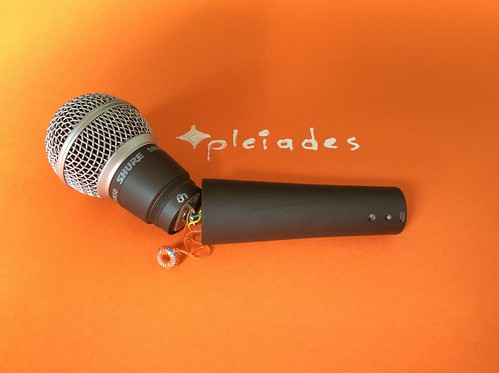
How it's done:
Some turns of insulated wire are wound on a toroidal ferrite or nanoperm core. The 2 ends of the inductor are soldered in parallel with the SM-58 voice coil. The core in this example must have been a Philips ferrite wound in around 2008? with 24 turns of wire wrap wire.
How it works:
If one speaks closely to a directional microphone bass increase takes place due to the proximity effect, which is an effect in some way analogous to what causes a tide (difference of gravity from the sun and moon on top and bottom of the earth, the moon is more effective as the difference between top and bottom is greater because it is nearer to us).. [1],[2].
An inductor has an impedance which drops with lowering frequency. At 0 frequency all you are left with is the resistance of the wire. It therefore short circuits low (bass) frequencies.
Inductors (coils) in electrical syatems are analogous to mass in mechanical system and therefore obey the analog of Newton's 2nd low. It says the more slowly you accelerate a mass the easier it is. Try moving back and forth a door at low and then high frequency. In electrical systems current is velocity and voltage is force. An inductor tries to keep current through it constant just as a mass tries to keep speed constant. The slower we move back an forth electrons in an inductor the easier it is, so bass frequencies are short circuited, the easy current makes a large voltage drop in the voice coil resistance. Similar to the rotating speed of a juice extractor dropping when you extract the juice of a fruit. This is conservation of energy and this energy converted to heat is what also acts as a brake to the membrane moving at low frequencies reducing pop and air blasts when the inductor is connected.
More wire turns more bass, or alternatively less turns more treble. Amazing clear treble.
Inspiration for the Pleiades filters came from the Director of Acoustical and Electromechanical of RCA H.F.Olson in his article: H.F. Olson, Ribbon Velocity Microphones, JAES, 1970 June, Vol 18.
An inductor is connected to the secondary of a ribbon microphone transformer
On this example the inductor is connected before the in house transformer of the SM58, right to the voice coil where the impedance is very low. This makes the construction very easy as very few turns are needed. The primary of the step up transformer is left connected to the voice coil as usual the step up the voltage and therefore impedance to 300 ohms.
Ref:
Hewitt, Conceptual Physics
Hadden, High Quality Sound Reproduction, BBC
H.F. Olson, Ribbon Velocity Microphones
No comments:
Post a Comment